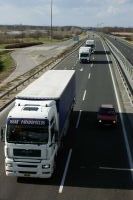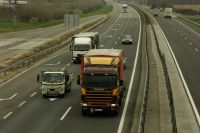|
The
shoes of Cinderella – why motorway construction is against
rural development?
Why Cinderella
is mentioned in the title? Because the shoe doesn't fits
the lady at all: the environmental impacts of motorways
are much more harmful, while the economic and social benefits
are significantly smaller, than policy-making supported
by the mass media suggests us. What is the rationale of
spending immense amount of public money on transport infrastructure
development instead of the wise use of local resources?
Why decision-makers seem to ignore that the shoes simply
do not fit???
‘Large scale public infrastructure investment, despite providing
a short-term demand boost, has frequently failed to stimulate
long term regional economic growth’
HM Treasury, Productivity in
the UK: (3) The Regional Dimension
So the shoes do
not fit the feet: the environmental impacts of road infrastructure
are not proportionate to the physical area covered by roads;
the impacts are significantly greater than the area occupied
would justify. Road networks and other infrastructure covers
about 2% of the Earth's surface, but the impacts are expanding
considerably over the physical area of roads. And while environmental
damage is larger than usually recognized, social and economical
benefits are much smaller than public opinion thinks – because
public is made to think that motorways are the key to economic
development, employment opportunities and social betterment.
We have to be aware that most of these arguments are false
and ungrounded. Studies and scientific findings of the last
30 years in this field have been neglected, by almost all
European governments.
The ecological
damage caused by roads is wide-scale and multiple; the following
list only includes some of the negative environmental aspects.
Infrastructure development affects the hydrological regime
and modifies the microclimate, changes the chemical composition
of the soil, significantly contributes to air pollution; and
noise disturbance also affects wildlife in a negative way.
Roads mean direct loss of habitat and destruction of flora
and fauna, but also trigger the fragmentation of habitats
and the reduction of the quality of the surrounding habitats.
Populations can become completely isolated, because roads
mean an impenetrable obstacle for most elements of wildlife
(lot of plants, reptiles, amphibians etc.). The resulting
changes in the dynamics of the affected populations increase
the risk of local extinctions, and impoverish genetic diversity.
Landscapes are spoiled, losing cultural, recreational and
aesthetical value, and giving way to invasive alien species.
The impacts of road infrastructure are so complex and far-reaching,
that we cannot predict or even describe them to full extent.
Nevertheless, huge amounts of public money are spent on building
motorways all across our landscapes, justifying this enormous
destruction by the social and economic benefits they bring
to rural communities. Several studies, for example the "Transport
and the Economy" report of the Standing Advisory Committee
on Trunk Road Assessment (SACTRA) in 1991 already underlined
that this is not necessarily true: there is no appropriate
evidence that road constructions provide high social returns.
This report explicitly states, that "the claims of national
economic benefits from new roads are exaggerated". The
cost-benefit analysis, which is a mandatory part of the construction
documentation, usually includes extremely overestimated economic
benefits, mainly in terms of GDP and job creation without
sufficient proof and missing baseline data, while the costs
– both environmental and social – are underrated.
Foreign examples clearly show that excessive infrastructure
development is not a heal-all for economy: a well known case
study is about Portugal and Ireland. After EU accession, Portugal
spent large amounts (22,8 billion EUR from EU funds) on constructing
road infrastructure with a view to boost rural development.
Nevertheless the Portuguese GDP growth was quite modest for
years, then turned negative in 2003. On the other hand, Ireland
invested in education, social partnership, human resources,
research and development. The Irish GDP growth was over an
annual 10% for years, and the country deserved the label of
"the economic wonder of the Western world". Although
the Irish economic model also gained certain criticism, this
comparison should ring the alarm bell in those who decide
to invest public money in infrastructure development.
While not realizing the expected favourable results, not appropriately
planned and implemented road networks can directly aggravate
the problems of already disadvantaged, peripheral regions:
roads are two-way, and they can easily take instead of bringing.
They take natural and human resources, leaving the affected
community just as poor, or even poorer than before. Tourism
is another industry often cited as a winner of road construction,
but evidence shows that easy access rather supports transit
traffic and short stays; therefore hardly any local income
is generated by the passing visitors. Motorways in several
cases led to net loss of jobs and the destruction of local
enterprises because services and products are brought from
other regions at a lower price. Qualified workforce left the
region, contributing to the ageing of the population, and
local markets crashed because of the "more competitive"
central markets – this is one of the findings of the "Economic
Impact of Motorways in the Peripheral Regions of the EU"
EURES study from 1996. Other development alternatives are
never examined, although in most of the cases better rural
development results could be achieved by more cost-effective
solutions, with significantly less financial investment and
less environmental damage.
"It is important that regeneration programmes start from
a firm understanding of the needs of an area. While a new
road may be a key issue in some locations, frequently the
answers to effective regeneration lie in improvements elsewhere.
Skills training, more demand responsive public transport services,
lower business rates, improved child care facilities or the
development of niche markets may all have more of an impact
on economic prosperity, depending upon the circumstances of
the area. In the rural environment this should also mean more
discerning development which is designed to meet specific
needs and recognises the importance of a high quality natural
environment for future economic success." – states the
before-mentioned SACTRA report.
This kind of negligence
of local needs directly conflicts with the principle of subsidiarity,
local autonomy and self-governance, because local governments
do not have any choice on how to spend the money dedicated
to road construction, and they are not asked whether they
could make better and more effective use of the given resources.
Local citizens, NGOs and certain authorities (such as nature
conservation authorities) are often not informed timely or
they don't have a voice in influencing the decision. This
approach is against all principles and policies of public
participation and contributes to the serious democracy deficit
of the European Union. In several cases these investments
involve the direct violation of the law, for example with
reference to the Aarhus Convention about the accessibility
of environmental information.
Road constructions violate other principles formulated in
the Treaty of the European Union: the principle of free economic
competition is distorted by the subsidies provided to road
transportation. Even the Sustainable mobility 2000-2004 action
program lays down that the current pricing schemes give unfair
and unjust advantage, environmentally harmful subsidies to
certain transportation modalities, while others (railways,
ports) are clearly disfavoured. The "polluter pays principle"
(also a basic principle of EU environmental policy) would
mean that the users of roads should pay the environmental
and health damages they cause. The EU transport policy adopted
in 2001 also states that each actor of the transportation
market should pay for the damages caused. Nevertheless, the
real beneficiaries of road infrastructure are not taking their
fair share of the burdens.
What could be a feasible alternative to excessive road construction?
The solution could be the overall reduction of mobility and
a decrease in the number of vehicles, the maintenance of already
existing microregional road networks instead of new motorways,
the development of public transportation – and first of all
wise rural development creating local employment, based on
local needs and local resources.
Further reading
The Cinderella principle:
http://www.cnr.usu.edu/faculty/jbissonette/documents/Cinderella.pdf
Principles of road ecology:
http://www.pc.gc.ca/pn-np/ab/banff/docs/routes/chap2/routes2_E.asp
Transport and Ecology conference:
http://www.icoet.net/ICOET_2003/03proceedings.html
Highway Mitigation Research:
http://www.pc.gc.ca/pn-np/ab/banff/docs/routes/routes1_e.asp
Campaign to Protect Rural
England:
http://www.cpre.org.uk/publications/transport/road-transport.htm
Blueprints for Sustainable
Transportation in Central and Eastern Europe
http://www.bankwatch.org/project.shtml?apc=--319796l--1&x=175194&d=n
Roads, Jobs and the Economy
http://www.eco-logica.co.uk/GPRoadsJobsEconomy.pdf
This article has been published
in the CEEWEB Diversity Newsletter
www.ceeweb.org
|





